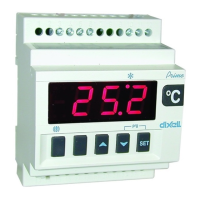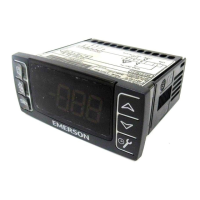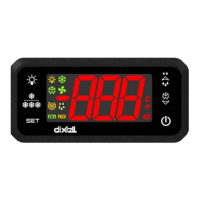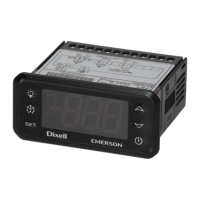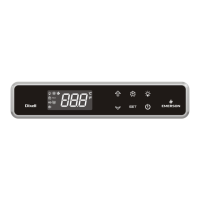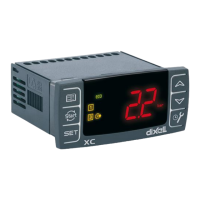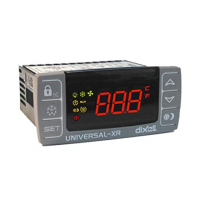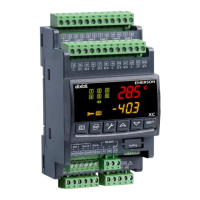In case of P4 error or if P4 is absent the output is at AMA value for the AMt time then the output is at 0
value for the time [255 – AMt] time performing a simple PWM modulation.
12.9 CLEANING MODE FUNCTION BY DIGITAL INPUT CONFIGURATION
The “cLn” value is added to the functions of the digital input.
The function has the same basic features of the stand by function, but with the following differences:
a. By the parameter LcL (no, yES) it’s possible to set if the light is on or off during cleaning mode.
This parameter LcL can be override by light button or by Light on/off Modbus command.
b. By the parameter FcL (no, yES) ) it’s possible to set if the fan is on or off during cleaning mode.
In case of fan on, the FSt parameter (fan stop temperature) is override.
12.9.1 Display
During the Cleaning Status, the display shows the “cLn” message.
12.10 AUXILIARY OUTPUT
The auxiliary output is switch ON and OFF by means of the corresponding digital input or by pressing and
releasing the down arrow key.
13. PARAMETER LIST
REGULATION
rtC Access to CLOCK submenu (if present);
Set Temperature set point (LS÷US)
Hy Differential: (0,1÷25,5°C; 1÷45°F): Intervention differential for set point, always positive.
Solenoid valve Cut IN is Set Point Plus Differential (Hy). Solenoid valve Cut OUT is when the
temperature reaches the set point.
LS Minimum set point limit: (-55.0°C
150°C; SET÷302°F) Set the maximum acceptable value for set
point.
OdS Outputs activation delay at start up: (0÷255 min) This function is enabled at the initial start up
of the instrument and inhibits any output activation for the period of time set in the parameter.
(AUX and Light can work)
AC Anti-short cycle delay: (0÷60 min) interval between the solenoid valve stop and the following
restart.
CCt Compressor ON time during continuous cycle: (0.0÷24.0h; resolution 10min) Allows to set
the length of the continuous cycle: compressor stays on without interruption for the CCt time. Can
be used, for instance, when the room is filled with new products.
CCS Set point for continuous cycle: (-55÷150°C / -67÷302°F) it sets the set point used during the
continuous cycle.
Con solenoid valve ON time with faulty probe: (0÷255 min) time during which the solenoid valve is
active in case of faulty thermostat probe. With COn=0 solenoid valve is always OFF.
CoF solenoid valve OFF time with faulty probe: (0÷255 min) time during which the solenoid valve
is off in case of faulty thermostat probe. With COF=0 solenoid valve is always active.
DISPLAY
CF Temperature measurement unit: °C=Celsius; °F=Fahrenheit. !!! WARNING !!! When the
measurement unit is changed the parameters with temperature values have to be checked.
rES Resolution (for °C): (in = 1°C; dE = 0.1 °C) allows decimal point display;
Lod Instrument display: (nP; P1; P2, P3, P4, P5, P6, tEr, dEF) it selects which probe is displayed by
the instrument. P1, P2, P3, P4, P5, P6, tEr= virtual probe for thermostat, dEF= virtual probe for
defrost.
rEd Remote display: (nP; P1; P2, P3, P4, P5, P6, tEr, dEF) it selects which probe is displayed by
the X-REP. P1, P2, P3, P4, P5, P6, tEr= virtual probe for thermostat, dEF= virtual probe for
defrost.
dLy Display delay: (0 ÷24.0 m; resolution 10s) when the temperature increases, the display is
updated of 1 °C/1°F after this time.
rPA Regulation probe A: (nP; P1; P2, P3, P4, P6) first probe used to regulate room temperature. If
rPA=nP the regulation is performed with real value of rPb.
rPb Regulation probe B: (nP; P1; P2, P3, P4, P5) second probe used to regulate room temperature.
If rPb=nP the regulation is performed with real value of rPA
rP3 Regulation probe 3: (nP; P1; P2, P3, P4, P6) third probe used to regulate room temperature,
with rPd = rAb, Aur, LoE, HiE
rP4 Regulation probe 4: (nP; P1; P2, P3, P4, P6) fourth probe used to regulate room temperature,
with rPd = rAb, Aur, LoE, HiE
rPd Temperature Regulation Strategy: (rPA, rAb, Aur, LoE, HiE)
rPA: temperature detected by the probe set in the parameter rPA
rAb: mix between rPA and rPb defined by rPE parameter
AUr: average temperature of all the probes defined as Regulation Probe in the parameters rPA,
rPb, rP3, rP4
LoE: minimum value among all the temperature probes defined as Regulation Probe in the
parameters rPA, rPb, rP3, rP4
HiE: maximum value among all the temperature probes defined as Regulation Probe in the
parameters rPA, rPb, rP3, rP4
rPE Regulation virtual probe percentage: (0 ÷ 100%) it defines the percentage of the rPA respect
to rPb. The value used to regulate room temperature is obtained by:
value_for_room = (rPA*rPE + rPb*(100-rPE))/100
DEFROST
dPA defrost Probe A: (nP; P1; P2, P3, P4, P6) first probe used for defrost.
dPb defrost Probe B: (nP; P1; P2, P3, P4, P6) second probe used for defrost.
tdF Defrost type: (Air, EL, in)
Air = Air defrost (defrost relay is not switched on during defrost)
EL = defrost with electrical heater;
in = hot gas defrost;
EdF Defrost mode: (rtc – in- Aut) (only if RTC is present) rtc= defrost activation via RTC; in= defrost
activation with idf; AUt = on demand defrost.
Srt Heater set point during defrost: (-55.0 ÷ 150.0°C; -67 ÷ 302°F) if tdF=EL during the defrost
the defrost relay perform an ON/OFF regulation with Srt as set point.
Hyr Differential for heater: (0.1°C ÷ 25.5°C , 1°F ÷ 45°F) the differential for heater;
tod Time out for heater: 0 ÷ 255 (min.) if the defrost probe temperature is bigger than Srt for all tod
time the defrost ends altough the defrost probe temperature is lower than dtE or dtS. It permits to
reduce defrost duration;
d2P Defrost with two probes: (n – Y) n= only the dPA probe is used to defrost management; Y=
defrost is managed with dPA probe and dPb probe. Defrost can performed only if both probe
value are lower than dtE for dPA probe and dtS for dPb probe;
dtE Defrost termination temperature (Probe A): (-55,0÷50,0°C; -67÷122°F) (Enabled only when
the evaporator probe is present) sets the temperature measured by the evaporator probe dPA
which causes the end of defrost;
dtS Defrost termination temperature (Probe B): (-55,0÷50,0°C; -67÷122°F) (Enabled only when
the evaporator probe is present) sets the temperature measured by the evaporator probe dPb
which causes the end of defrost;
IdF Interval between defrosts: (0÷120h) Determines the time interval between the beginning of two
defrost cycles;
idE Time to next defrost log into not volatile memory
no: time to next defrost is not logged into no volatile memory, this means controller will use the
idF interval after a power off. E.I. idF = 8: controller performs a defrost every 8h. If controller is
switched off, independently from when last defrost happened, at power on it will do the first defrost
after 8 hours.
yES: time to next defrost is logged into no volatile memory, this means controller will use it after
a power off. E.I. idF = 8: controller performs a defrost every 8h. If controller is switched off 6 hours
after last defrost, at power on it will do the first defrost after 2 hours (6+2 = 8). It is useful in places
subjected to frequent power outages.
ndt Minimum duration of defrost: (0÷MdF min) it sets the minimum defrost duration, independently
form the temperature reached by the end defrost probes;
MdF Maximum duration of defrost: (ndt÷255 min) When dPA and dPb aren’t present, it sets the
defrost duration, otherwise it sets the maximum duration for defrost;
dSd Start defrost delay: (0 ÷ 255 min) This is useful when different defrost start times are necessary
to avoid overloading the plant.
dFd Display during defrost: rt = real temperature; it = temperature reading at the defrost start; Set
= set point; dEF = “dEF” label;
dAd Defrost display time out: (0
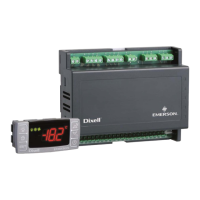
